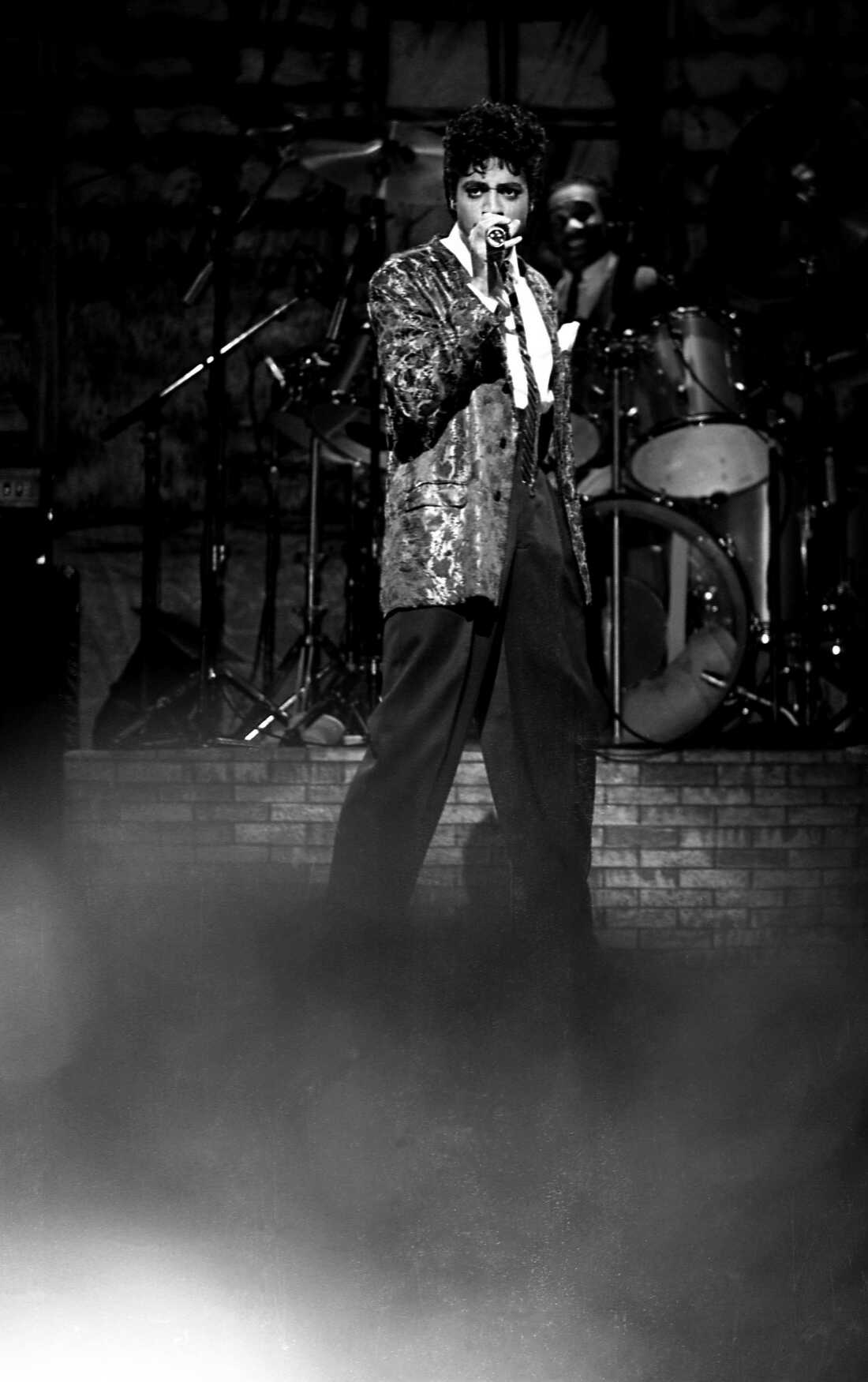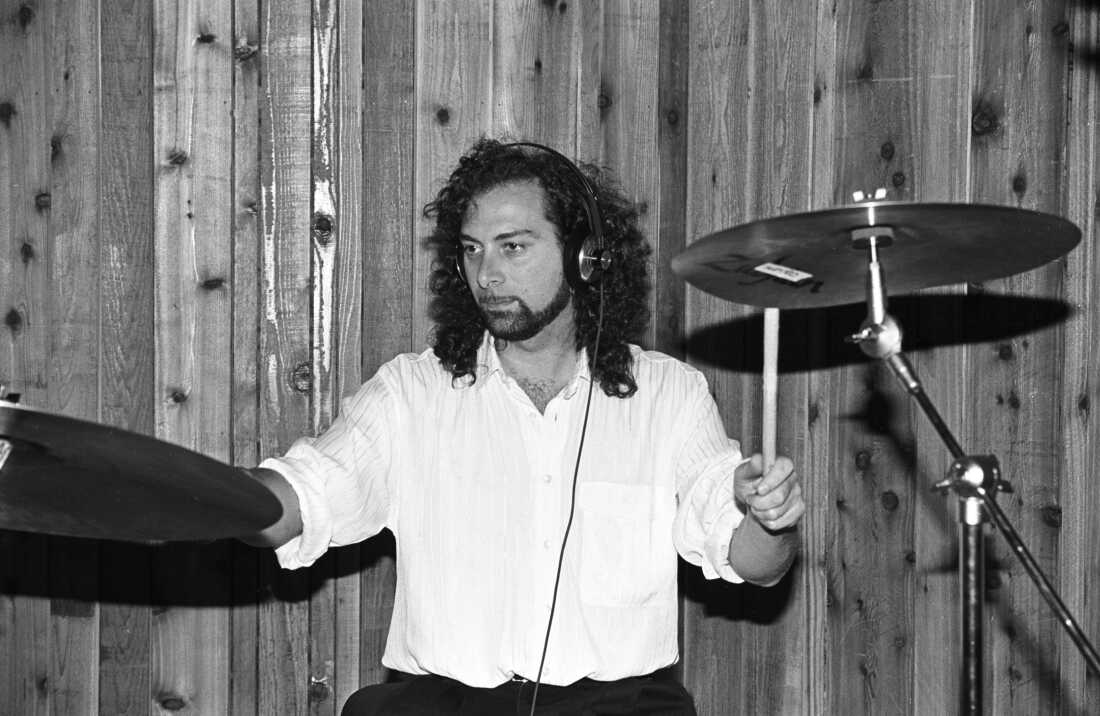
Prince on the custom motorcycle featured in Purple rain.
Cinematic/Alamy
hide legend
toggle caption
Cinematic/Alamy
Wendy Melvoin, guitarist for Prince’s band The Revolution, recalls that one of their most iconic songs began with an idea — and a challenge — from the boss himself.
Prince broached the subject at a band rehearsal. “He came to the table with this great idea… most of the songs (on the album) had already been done,” Melvoin says. “He said, ‘I have this idea and it sounds a little bit like this… what do you have?'”
Wendy had an idea for a gloomy cascade of guitar chords that turned out to be the perfect starting point.
“I came up with this intro and chord progression to get us into the mood of the song,” she adds. “And it turned out to be one of the most iconic intros to a pop ballad.”
The song Purple rain would become the surprising and anthemic climax of a film of the same name that would prove to be one of the most successful and influential musical films in history. The film hit theaters 40 years ago, breaking barriers in the music world while signaling Prince’s rise to pop superstardom.
Putting Purple Rain on the big screen
Filmed around the band’s hometown of Minneapolis, Purple rain The story of Prince is simple. Prince’s character, known only as The Kid, is shaken by his father’s constant beating of his mother at home, his difficulty bonding with his bandmates, and a new romantic interest, a beautiful singer named Apollonia.
Drummer Bobby Rivkin, known on stage as Bobby Z, says the idea to feature Prince and The Revolution songs in a film was inspired by the success of MTV and its interest in music videos.
“Prince was always someone who went beyond the cultural things that were happening at the time,” he adds. “Once MTV started playing his videos, I think he looked to something bigger and thought, ‘I’m just going to take it to the next level.’”
Melvoin says she and The Revolution — including Rivkin, keyboardists Lisa Coleman and Matt Fink, and bassist Brown Mark — found out they were working on a film when Prince made it very concrete during a rehearsal. But she wasn’t worried about whether she’d be able to perform or how the band would look on screen.
“I think if I had any concern at the time, it was just, ‘Would the story be good?’” she says with a laugh. “I had no doubt that the musical sequences would be fantastic. But I didn’t really have any idea that the narrative of the film was going to work.”

It turns out that everything worked out pretty well. Purple rain was a success, with the film and its soundtrack winning an Oscar, two Grammy Awards and breakthrough musical film status.
The film also helped introduce audiences to Prince’s raunchy playing style, his unerring ability to create hits, and his distinctive fashion sense. Prince’s network of bands and artists also attracted attention, including the girl group Apollonia 6 and the funk band The Time.
Time’s lead singer Morris Day and his stage partner Jerome Benton became the comedic center of the film, with both taking inspiration from a version of the classic Abbott and Costello number “Who’s on First?”
“We honestly weren’t trying to be funny… we were always clowning around at the time because we were young,” Day said, responding to questions via email. He noted that while the actors took acting and dance classes in preparation for filming, “we were just being ourselves. I was actually more concerned with being cool than funny.”

Morris Day of The Time performed in Chicago in 1983, before the release of Purple Rain.
Raymond Boyd/Getty Images
hide legend
toggle caption
Raymond Boyd/Getty Images
He’s not surprised that people are still talking about the film four decades after its initial release.
“The movie was revolutionary on so many levels… it was the first of its kind,” adds Day, who says he’s only seen the entire film once, when it premiered in Hollywood on July 26, 1984. “It reminds people in a way of a particular time in their lives in the ’80s, a time we all sometimes wish we could have back.”
Building the Drama in Purple Rain
Fans know the film tells a more combative story behind the song’s genesis. Purple rain.
Onscreen, Melvoin and his then-girlfriend, keyboardist Lisa Coleman, write the song, battling a reluctant Prince — known only as The Kid in the film — to let The Revolution perform it on stage.

“Every time we give you a song, you say you’re going to use it, but you never do,” Melvoin yells at Prince during the scene, providing some of the best acting from the musicians who make up most of the cast. “You think we’re doing something behind your back… you’re just being paranoid as usual.”
When Prince finally agreed to play Purple Rain live at Minneapolis’s First Avenue club—launching into a stirring rendition topped with one of the greatest guitar solos in pop music—he wowed the crowd and saved the band. But Melvoin now says the friction they experienced was “movie magic” conjured to construct a story; in real life, she, Lisa, and Prince were very close collaborators.

The prince, alongside Wendy Melvoin (left) and Lisa Coleman (right) accepts Purple rainOscar for Best Original Score in 1985.
HARMS/AFP via Getty
hide legend
toggle caption
HARMS/AFP via Getty
Fueled by hits like the title track and the percolating dance jam I would die for you, Purple rain burst like a lavender-tinged explosion across the pop culture landscape – propelling Prince’s growing fame into the stratosphere.
The innovative dance tube When doves cryrecorded by Prince without a bass guitar, became his first number one single on Billboard’s Top 100 singles list. It was followed by his second number one single, the rock and soul classic Let’s be crazywho showcased his guitar skills at a time when rock guitar was not often heard on R&B records.
Giving fans a glimpse behind the mystique
Prince had developed a certain mystique by rarely speaking to the press. So, back when YouTube and Tik Tok didn’t exist, Purple rain offered a sustained – if fictionalized – look at the inner workings of the band and its origin story for fans eager to know more.


And this was a group of performers who were a mix of Midwestern identities and ethnicities, making music that crossed all sorts of cultural barriers, at a time when people like that were rarely seen on the big screen.
“This movie was Prince’s version of social media,” Melvoin says. “It’s funk rock and no one has ever seen a movie based on that kind of life. It was a journey for people.”
But there were also criticisms. Most of the film’s actors were amateurs, which was reflected in their acting. And the female characters were often poorly treated on screen: in one scene, Jerome Benton disposes of a hostile woman who confronts Day by throwing her into a dumpster.
“Given today’s culture, I’m sure there are moments in the film that will annoy a lot of people,” Day says. “Overall, I’d like to think we did a great job. And based on the vast majority (of audience reactions), I think we did.”
The film ultimately proved to be the perfect showcase for Prince’s boundless creativity—from his ruffled shirts and broad-shouldered clothing to his blend of religion and sexuality in his lyrics, his innovative recording methods, and his seemingly endless supply of high-quality songs.

Bobby Rivkin, otherwise known as Bobby Z, during a recording session in 1989.
Jim Steinfeldt/Michael Ochs Archives/Getty Images
hide legend
toggle caption
Jim Steinfeldt/Michael Ochs Archives/Getty Images
“MTV opened the door a little bit – just a little glimmer – and he kicked it open,” Rivkin adds. “He was innovative in fashion and culture. And it was a remarkable time for him. From his humble beginnings to his control of black culture, crossover culture… rock, funk, pop… he was on fire for a long time.”
Continue without the boss
A few years and albums later, Prince disbanded The Revolution. But the band has reunited a few times, including for a benefit concert after Rivkin’s first heart attack in 2010, and after Prince died in 2016, at age 57, of an accidental fentanyl overdose. Most recently, the band reunited last month to perform at a five-day event in Minneapolis celebrating Purple rain40th anniversary of.
Both Melvoin and Rivkin hope The Revolution can play more concerts commemorating Purple rainThey will celebrate their anniversary next year. But they also admit that it can be difficult to perform without their frontman and dynamic leader, even if playing together helps them overcome the loss.
“After he passed away, all we could think about was being together and grieving,” Melvoin said.
And what would The Kid himself think of the legacy his hit movie and album would leave him? Day says he’s not sure.
“(Prince) never liked to stay in the past,” the singer adds. “He was always evolving. Purple rain “Once he was done, he moved on to the next one. But now that I think about it, he could have thrown a big party at Paisley Park for the fans. It probably would have been a hell of a jam session.”